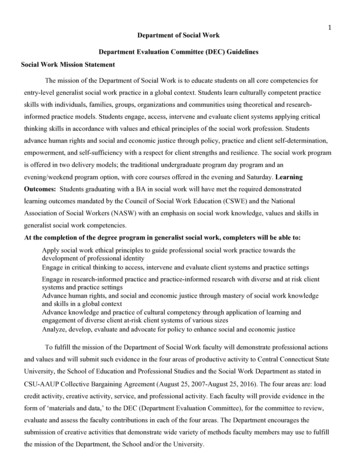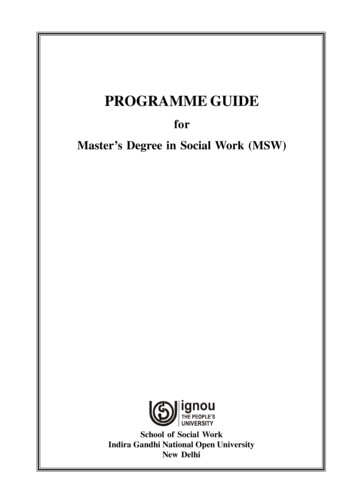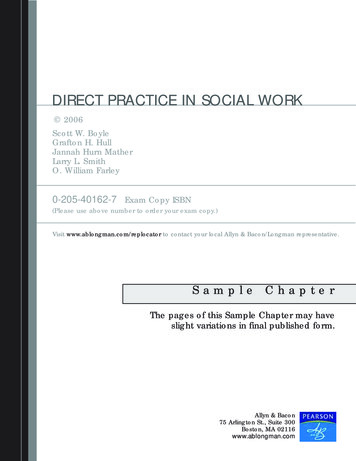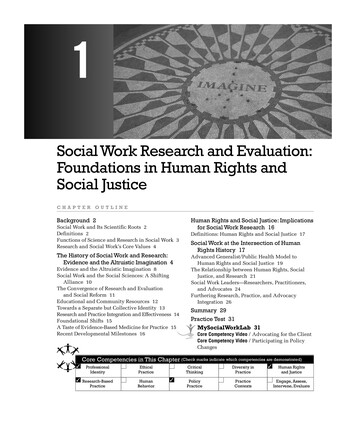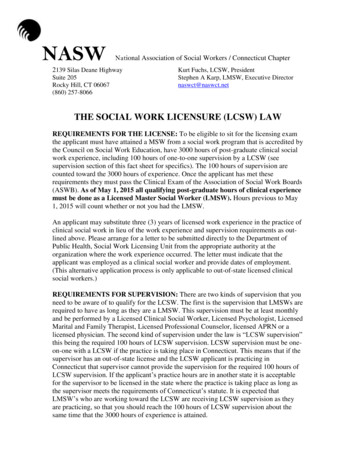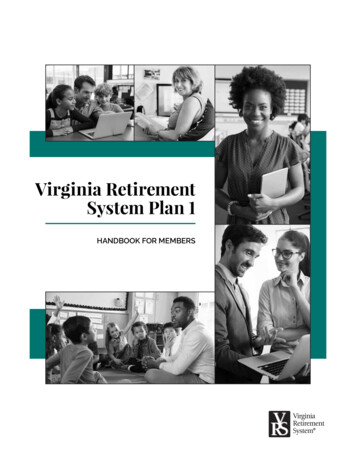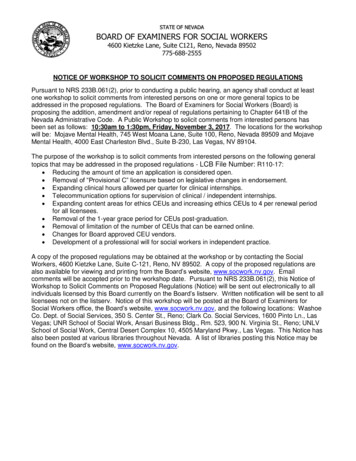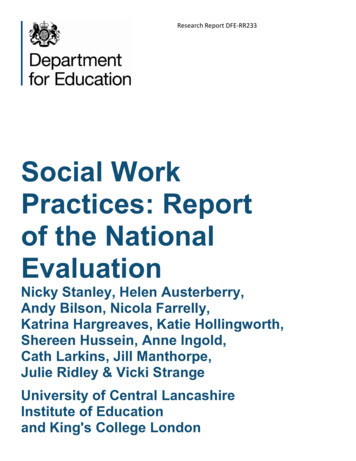
Transcription
Research Report DFE-RR233Social WorkPractices: Reportof the NationalEvaluationNicky Stanley, Helen Austerberry,Andy Bilson, Nicola Farrelly,Katrina Hargreaves, Katie Hollingworth,Shereen Hussein, Anne Ingold,Cath Larkins, Jill Manthorpe,Julie Ridley & Vicki StrangeUniversity of Central LancashireInstitute of Educationand King's College London
This research report was commissioned before the new UK Government tookoffice on 11 May 2010. As a result the content may not reflect currentGovernment policy and may make reference to the Department for Children,Schools and Families (DCSF) which has now been replaced by the Departmentfor Education (DfE).The views expressed in this report are the authors‟ and do not necessarilyreflect those of the Department for Education.
AcknowledgmentsWe are grateful to all children, young people, parents, carers and practitioners who haveassisted with this research as participants and respondents as well as to those who havefacilitated data collection in the pilot and comparison sites and at national levels. We thankDepartment for Education staff and members of the Evaluation Advisory Group for their support.The design above was contributed by young people from the evaluation‟s Young People‟sAdvisory Group.
ContentsEvaluation of Social Work Practices: Executive Summary . iIntroduction . 1The Background . 1The Evaluation . 4Aims and Methodology . 4Constructing Samples and Collecting Data . 5Analysis . 9Limitations . 9The Changing Context of the Evaluation . 10Report Coverage . 11Chapter 1 –SWP Pilot Commissioning and Start-up . 121.1 Commissioning SWPs . 121.1.1 Local Authorities‟ Commissioning Processes . 121.1.2 Developing Bids . 141.1.3 Payment by Results . 151.1.4 Selecting a Successful SWP Bid . 151.2 SWP Start-Up . 171.2.1 Staff Transfer and Recruitment . 171.2.2 Size, Complexity and Location of Cohort . 181.2.3 Transferring the Cohort . 191.2.4 Children‟s and Young People‟s Choices about Transfer . 201.2.5 Parents‟ Choices about Transfer . 231.2.6 Transferring Case Files . 231.3. SWP Offices and Equipment . 24Chapter 1 Summary Points . 25Chapter 2 - The SWP Pilots in Operation . 272.1 Pilot Staff . 272.1.1 Key Characteristics of the SWP Workforce . 272.1.2 Staff Views on SWP Ethos . 312.2 In-house SWP . 342.2.1 Benefits and Challenges of being In-house . 352.3 Staff Involvement in Decision Making . 35
2.3.1 Advantages and Disadvantages of Flatter Management Structure and StaffInvolvement in Decision Making . 362.3.2 Financial Decision Making . 382.4 Advantages and Challenges of Devolving Budget Responsibilities to Front-line Staff. 392.4.1 Multi-disciplinary Teams . 392.4.2 Small Teams . 402.4.3 A Personalised, Flexible Service . 412.4.4 Advantages and Disadvantages of Offering a Personal, Flexible and AccessibleService . 422.4.5 Reducing Bureaucracy and Paperwork . 422.5 Support for the Pilots . 442.6 Children‟s and Young People‟s Participation in the Pilots . 452.6.1 Children‟s and Young People‟s Understanding of SWPs . 462.6.2 Young People, Participation and Governance . 472.7 Future of the Pilots . 51Chapter 2 Summary Points . 52Chapter 3 - Other Perspectives on SWP Operations . 543.1 Other Professionals‟ Perspectives. 543.1.1 Other Professionals‟ Understandings of the Pilots . 543.1.2 SWP Practice and Planning . 543.1.3 Implementation of Plans . 553.1.4 Quality of Direct Work with Children and Families . 553.1.5 Stability, Accessibility and Communication . 573.1.6 Impact of SWPs on Local Authorities and Other Agencies . 583.1.7 Perceptions of Children‟s and Young People‟s Satisfaction with SWPs . 593.1.8 Summary of Other Professionals‟ Perspectives . 593.2 IRO Perceptions . 593.2.1 Children‟s and Young People‟s Attendance and Participation in Reviews . 603.2.2 Implementation and Follow-Up of Plans . 603.2.3 IRO Views of Direct work with Children and Young People, Families and Carers. 613.2.4 IRO Perceptions of Continuity and Stability . 613.2.5 IRO Perceptions of Accessibility of Social Workers . 623.2.6 Summary of IRO Perceptions . 63
3.3 Local Authority Commissioners‟ Perspectives on the Pilots . 633.3.1 Identified Benefits . 633.3.2 Identified Risks . 643.3.3 Pilot Finances . 653.3.4 Impact of SWPs on Children‟s Services . 653.3.5 Impact on Commissioning . 663.3.6 Future Prospects for SWPs . 673.4 Care Planning and Reviews . 673.4.1 Extent to which Plans were in Place . 683.4.2 Children‟s and Young People‟s Awareness of and Involvement in Care Planningand Reviews . 683.4.3 Involvement of Others in Care Plans and Reviews . 703.4.4 Changes in Care Plans . 713.4.5 Summary of Care Planning and Reviews . 72Chapter 3 Summary Points . 72Chapter 4 - Children‟s and Young People‟s Views and Experiences . 754.1 Perceptions of Allocated Workers . 764.1.1 Continuity and Transition . 764.1.2 Accessibility and Responsiveness . 764.1.3 Out-of-hours and Holidays . 794.1.4 Quality of Relationship . 804.2 Knowing the Offices and Other Staff . 824.3 Safety and Support. 834.4 Contact with Family . 864.5 Placements and Accommodation . 884.6 Speed of Decision Making . 904.7 Overview of Children‟s and Young People‟s Views and Experiences . 91Chapter 4 Summary Points . 91Chapter 5 - Parents‟ Perceptions and Experiences . 935.1 Parent Characteristics . 935.2 Information about the Pilot . 935.3 Continuity and transition . 945.4 Perceptions of Allocated Workers . 945.4.1 Accessibility and Responsiveness . 945.4.2 Quality of Relationships . 96
5.5 SWP Offices and Other Staff . 975.6 Relationships with Carers . 985.7 Contact . 995.8 Levels of Support . 1005.9 Involvement and Engagement in Decision Making . 1025.9.1 Disagreements with Social Workers . 1025.9.2 Involvement in Reviews . 1025.9.3 Comparison with Previous Experiences of Involvement in Decision Making . 1035.10 Overview of Parents‟ Perceptions and Experiences . 103Chapter 5 Summary Points . 104Chapter 6 - SWP Impact on Carers . 1056.1 Survey Response Rates. 1056.1.1 Demographic Characteristics of Carers and Children at Time 1 . 1076.1.2 Demographic Characteristics of Carers and Children at Time 2 . 1086.2 Analysis of Survey Data . 1126.2.1 Survey Results. 112Chapter 6 Summary Points . 119Chapter 7 - Impact on the Workforce . 1207.1 Participants‟ Profiles . 1207.2 Expectations of SWPs . 1217.3 Time Expenditure . 1217.4 Perceived Workloads . 1237.5 Views on Quality of Care and Relationships . 1247.6 Views on Staff Autonomy, Participation and Support . 1257.7 Job Satisfaction, Job Content, and Burnout Levels . 1277.7.1 Job Satisfaction . 1277.7.2 Karasek Job Content Questionnaire (JCQ) . 1277.7.3 JCQ: Psychological Job Demand . 1297.7.4 JCQ: Job insecurity . 1307.7.5 Maslach Burnout Inventory (MBI) . 1317.7.6 Emotional Exhaustion (EE) . 1327.7.7 Depersonalisation (Dp) . 1327.7.8 Personal Accomplishment (PA) . 1327.8 Overview of Impact on the Workforce . 133
Chapter 7 Summary Points . 134Chapter 8 - Conclusions and Key Messages . 1358.1 Organisational Issues . 1368.1.1 The Role of the Local Authority. 1368.1.2 Commissioning SWPs . 1368.1.3 The Professional Partnership Model . 1368.1.4 SWP Finances . 1378.1.5 Payment by Results . 1378.1.6 Round-the-Clock Services . 1378.1.7 Small is Beautiful but Risky. 1378.1.8 Time Allocation and Caseload Size . 1388.1.9 Interprofessional Work . 1388.2 Impact of SWP Pilots on Children and Young People, their Parents and Carers . 1398.2.1 Choosing SWPs. 1398.2.2 Continuity and Consistency . 1398.2.3 A More Responsive Service?. 1398.2.4 Contact and Birth Families . 1408.2.5 Children‟s Participation . 1408.2.6 User-friendly Buildings . 1408.3 Impact of SWPs on Carers . 1418.4 Impact of SWPs on the Workforce . 141References . 144Appendix 1 - Evaluation Advisory Group to the Social Work Practices Evaluation . 149Appendix 2 - Interview Schedule for Children and Young People – Time 1 . 150Appendix 3 - Practitioners Survey . 160Appendix 4 - The Characteristics of Children and their Outcomes in Pilot, Host andComparison sites: Using SSDA903 Data . 171Appendix 5 - Account of Statistical Analysis of Carers Survey . 198Appendix 6 - Chapter 8 Tables and Figures . 204
Evaluation of Social Work Practices: Executive SummaryNicky Stanley, Helen Austerberry, Andy Bilson, Nicola Farrelly, Katrina Hargreaves, KatieHollingworth, Shereen Hussein, Anne Ingold, Cath Larkins, Jill Manthorpe, Julie Ridleyand Vicky StrangeThe Social Work Practice PilotsFive social work practice (SWP) pilots started up in England between December 2009 and May2010. These independent organisations were commissioned by local authorities to provideservices for looked after children and care leavers. The pilots were introduced to discoverwhether smaller social work-led organisations independent of local authorities could improve themorale and retention of social workers and bring decision making closer to front-line practice.These changes were expected to deliver increased consistency and stability of care for lookedafter children and care leavers. The pilots have differed substantially in their organisationalforms and their origins and in the numbers and profiles of looked after children and youngpeople they support (the Cohort). The SWPs comprised:SWP AAn in-house SWP which has remained within the local authority as a separateand discrete unit. Cohort of 180 young people aged 14-21.SWP BA professional practice run as a private company by an organisation that alreadydelivered social care training. Cohort of 80 children and young people aged 8-17with high levels of need.SWP CA voluntary organisation already providing the local authority‟s care leavingservice. Taking on the attributes of an SWP was a gradual process for analready established service. Cohort of 582 young people aged 16-24 at start-up(increased to 727 by Nov 2011).SWP DAn SWP run by a voluntary organisation with a long history of providing servicesfor local authorities. The SWP was a new venture for this organisation and staffwere recruited specifically to this service. Cohort of 120 children and youngpeople aged 0-17.SWP FA professional practice run as a social enterprise established by a group of socialwork practitioners who formerly worked for the host local authority and whomoved out to form the SWP, taking with them responsibility for many of thechildren with whom they already worked. Cohort of 148 children and youngpeople aged 8 and above.A sixth pilot failed to start as the local authority was diverted by an Ofsted inspection report thatrequired it to focus on its core functions. At May 2012, three pilots looked set to continue until atleast 2013 when contracts for those outside the local authority come up for renewal. However,two of the pilots had learnt that the local authorities would not be renewing their contracts andplans for returning these children and young people to the care of the local authorities were inplace.The EvaluationAn independent evaluation was commissioned by the Department for Education (formerly theDepartment for Children, Schools and Families) to:i
1. analyse the advantages and disadvantages of the overall Social Work Practiceconcept, and the specific benefits (or otherwise) of the different models employedand any lessons for alternate models;2. identify the impact of SWP pilots on children, their carers and their families;3. discover the impact of the SWP model on the children's social care workforce;4. identify the impact of SWP pilots on statutory child care social work in the hostlocal authorities and on the work of other agencies.The evaluation employed a matched control design with integral process evaluation; the localauthorities piloting SWPs were matched with six carefully selected comparison sites. A widerange of data has been collected and brought together for analysis including: 225 interviews with looked after children and care leavers – 121 children and youngpeople were interviewed from the pilots (56 were interviewed twice) and 48 fromcomparison sites.31 interviews with SWP Staff (in 2010 and 2011; 12 were interviewed twice), interviewswith 7 SWP Project Officers, 10 Local Authority Commissioners and 13 interviews withmembers of the SWP Evaluation Advisory Group (EAG).Interviews with 11 young people involved in SWP governance at different points in time.Interviews with 19 birth parents of children and young people looked after by SWPs.Interviews with 22 professionals from a range of social, education and health careagencies and with 21 Independent Reviewing Officers (IROs) in the five pilot sites.45 care plans from pilots and comparison sites were analysed and compared.Data supplied by the pilots on their looked after children and workforce.Analysis of data on key measures included in the DfE‟s SSDA903 returns for the pilotand comparison sites.On-line baseline (1101 responses) and second (949 responses) surveys of localauthority practitioners in the pilot and comparison sitesCarers‟ baseline (1,782 responses) and second (1,676 responses) postal surveys offoster carers, kin carers and managers of residential homes and supported lodgingsacross the pilot and comparison sites.Key FindingsThe evaluation has yielded mixed findings with stronger evidence in relation to some aspects ofthe pilots‟ work than in others. The views of stakeholders, such as IROs, other professionals,local authority commissioners and EAG members, as to whether the SWPs performed betterthan their local authority counterparts or whether they represented good value were divided.There were also variations found in perceptions of different pilots with some emerging asstronger performers than others.Despite this variety, there is some evidence of positive change for children, parents, carers andthe workforce that can be attributed to the pilots and this is highlighted below.The Role of the Local Authority“If you were to analyse all the Social Work Practices that are working very well it‟sbecause they have a good relationship with the local authority.” (SWP Staff Member)The partnership with the local authority was fundamental to the survival and achievements ofthe SWPs who were reliant on local authorities for a range of services, expertise and support.ii
The in-house SWP, which was the pilot that was most dependent on the parent local authority,emerged as a viable model while the other pilots depended on the parent local authority forvarious key functions such as out-of-hours services, IT systems, rental of premises andequipment, training, supervision, legal services, access to psychological services for childrenand advice on complex cases and child protection issues. Reliance on the local authorityconstrained the autonomy of the pilots to differing extents: in particular, only one SWP had fullcontrol over the placement budget. In the light of this, it is difficult to see how SWPs wouldfunction were local authorities to move all their children‟s services out into SWPs as some localauthorities are reportedly contemplating. In the case of such a scenario, some of the corefunctions and expertise of the local authorities essential for the success of SWPs would be lost.Commissioning SWPs„They were just finding the process difficult in terms of the amount of work and whenthey actually got the tender document and saw what they had do to produce in terms ofgetting everything ready, they baulked at that ‟ (Project Manager)Commissioning was experienced as an arduous process for all concerned despite the supportprovided by government appointed consultants. Small groups of social workers who cametogether to bid for a professional partnership were disadvantaged and dissuaded by the timerequired and their lack of business experience. Larger organisations with the infrastructure tosupport the bidding process fared better.The Professional Partnership ModelThe two pilots that were most frequently and consistently described as respectively successfuland failing by stakeholders were both professional partnerships. That is, they were smallorganisations run by social workers themselves. However, the pilot that was consistentlyidentified as successful was a social enterprise established by social workers moving out of thelocal authority and the other was a private profit-making company run by social workers whoalready operated a social care business. A key factor distinguishing these two pilots was thecloseness and strength of the relationship with the relevant local authority.SWP FinancesWhile this evaluation did not include a full cost-benefit analysis, local authority commissionersdid not consider that the pilots had reduced costs and, in some cases, costs were considered tobe higher than those of the equivalent in-house service. The impact of local governmentspending cuts on SWPs was discernible in decisions to terminate contracts while highernumbers of looked after children led to demands for them to add to SWP numbers resulting inlarger caseloads for some pilots in the second year.Payment by Results (PBR)This was a controversial aspect of the original SWP model that attracted considerable criticism.In the event, only two SWPs used it and this was in relation to savings on the placement budgetrather than outcomes for LAC and care leavers. Only three local authorities monitored pilotoutcomes for children and young people systematically and it therefore seems unlikely that pilotstaff were motivated to deliver a higher quality service by a system of rewards, although in thetwo sites that used PBR there was an incentive to select cheaper placements.Round-the-Clock ServicesThe requirement for SWPs to provide a round-the-clock service was identified as a disincentivefor organisations bidding for pilots and impacted on the cost of the pilots. Only two sites wereiii
providing their own out-of-hours services by 2012. Children and young people reported makinglimited use of out-of-hours services and, when they did, this usually took the form of informalcontact with their individual worker. It was notable that this informal out-of-hours contact alsooccurred in some comparison sites.Small is Beautiful but Risky„ even the receptionist lady, I can phone her up and she knows who I am, Ican speak to her about anything.‟ (Parent)In common with other studies, various benefits were associated with small size. Children,young people and parents valued the flexibility
The Social Work Practice Pilots Five social work practice (SWP) pilots started up in England between December 2009 and May 2010. These independent organisations were commissioned by local authorities to provide services for looked after children

